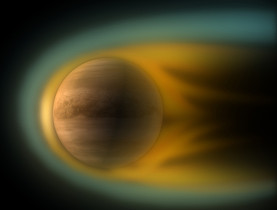
Sun strips away Venus’s water

Solar wind is slowly stripping away water found in Venus's atmosphere, making the planet hotter and more inhospitable than ever, say scientists.
Swiss and international researchers have been scrutinising the Earth’s nearest neighbour with Venus Express, a European Space Agency probe, to understand how planets develop.
Venus, the second rock from the sun, is a hot and inhospitable place where the surface pressure is 90 times stronger than that found on Earth. Not a place where you would want to spend your weekend, yet scientists find it fascinating.
“The major question for us is why Earth doesn’t resemble Venus and Mars. They benefited from much the same conditions when they formed, so why are they so different?” said Peter Wurz, a professor at Bern University’s physics department.
The European Space Agency (Esa) decided to go looking for some of the answers and budgeted €220 million (SFr352 million) for the Venus Express mission, which has been orbiting the planet for nearly two years.
The cost was actually lower than might have been expected after technology developed for the earlier Mars Express project was recycled.
Wurz is just one of the many scientists with an interest in the mission. He took a closer look at the solar wind – the continuous flow of charged particles from the sun which travel through the solar system.
“The solar wind interacts with Venus’ atmosphere and this causes erosion of atmospheric particles,” he told swissinfo. “Our measurements showed that there is a flow of these particles heading into space.”
“Venus’ current atmosphere is almost entirely carbon dioxide (CO2),” he added. “Virtually everything else has been removed, especially much of the water that probably always existed on the planet in a gaseous state.”
This, he says, is the result of selective erosion. Venus, like Earth, is a massive planet with substantial gravity. CO2 stays closer to the ground and is not stripped away, whereas lighter elements rise through the atmosphere and are affected by the solar wind.
Greenhouse effect
Because of this, Venus has endured a dramatic greenhouse effect, which has helped raise the temperatures on the surface to a blistering 465 degrees Celsius.
“Water was never in liquid form on Venus, so there was never any ocean that could help bind CO2 in minerals and remove it from the atmosphere, lowering temperatures,” said Wurz. “On Earth we have oceans that have absorbed carbon dioxide and helped fix it in minerals such as limestone.”
Another major difference between Venus and Earth is that our planet is protected by a large magnetic field.
“It’s like a large bubble that solar wind has to flow around and therefore does not interact with our atmosphere,” Wurz told swissinfo. “For the past 4.5 billion years, this field has protected us from the solar wind’s bad effects.”
With the magnetic field produced by the Earth’s inner core, it is unlikely to disappear anytime.
But if it did happen, Earth would resemble Mars, its other neighbour in the solar system, after several hundred million years. The atmosphere would be around one hundredth the thickness it is today.
Solar cycles
But given that there is no rush to understand the workings of Venus, why bother? Wurz can think of few good reasons.
“Immediate implications of our research are the study of solar cycles. When a cycle is at its high point, this can mean disturbances on Earth to the power network, the destruction of satellites or of other high technology systems,” he said.
Next stop though for Wurz and his colleagues is Mercury. Esa is already preparing the BepiColombo mission, which should be launched in 2013.
“Mercury is basically a big stone, but with a magnetic field,” Wurz told swissinfo. “It has few parameters to deal with, so you can understand more easily how its magnetic field interacts with the solar wind.
“If you understand a simple system, you can then consider a more complicated one like Earth’s.”
swissinfo, Scott Capper
Venus Express is ESA’s first spacecraft to voyage to our nearest planet; it was designed to observe the Venusian atmosphere and clouds in unprecedented detail and accuracy.
The spacecraft is basically a honeycomb aluminium box about 1.5 metres wide. With its solar arrays fully extended, it measures about 8 metres across. The scientific instruments are mounted on the aluminium structure.
The payload is constituted of a set of seven instruments able to study the atmosphere, plasma (solar wind) environment and surface of the planet in great detail.
The Bern scientists worked with the Aspera instrument, designed to study how molecules and ions escape the planet.
Venus orbits the sun every 224.7 Earth days. It is the brightest natural object in the night sky, except for the moon, and is also the closest planet to Earth.
Venus is at its brightest shortly before sunrise or shortly after sunset, which is why it is often called the Morning Star or the Evening Star.
It is sometimes called Earth’s “sister planet”, as the two are similar in size, gravity, and composition.
Unlike Earth, Venus is covered with an opaque layer of highly reflective clouds of sulphuric acid, preventing its surface from being seen from space in visible light. It was first mapped using radar imaging by Nasa’s Magellan space probe in the early 1990s.

In compliance with the JTI standards
More: SWI swissinfo.ch certified by the Journalism Trust Initiative




























You can find an overview of ongoing debates with our journalists here . Please join us!
If you want to start a conversation about a topic raised in this article or want to report factual errors, email us at english@swissinfo.ch.